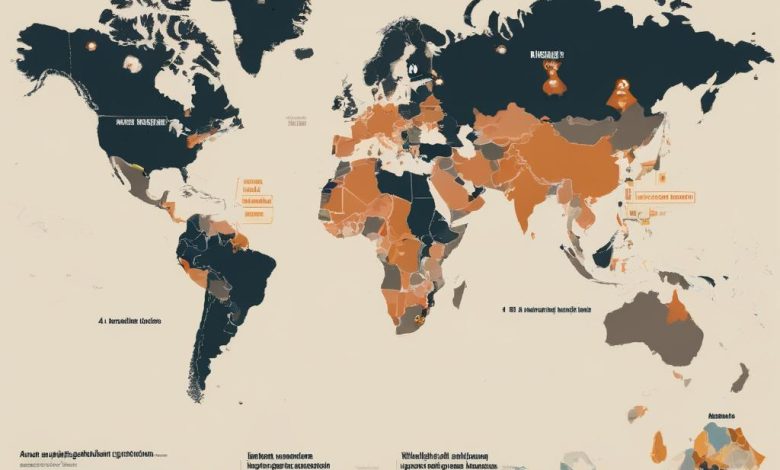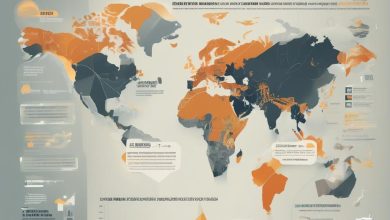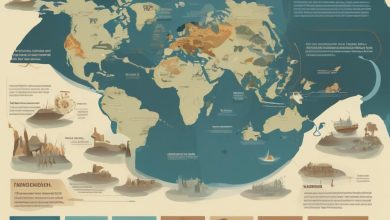Refugee Crises Reshape Global Migration Policies

Refugee Crises Reshape Global Migration Policies
Today, we see a huge refugee crisis around the world. Millions have left their homes because of war, persecution, and natural disasters. This crisis is changing how countries handle migration, as they try to protect and help those seeking safety.
This article looks into how the refugee crisis is changing global migration. We’ll see what drives people to move, the problems faced by host countries, and new ways to tackle this issue. Understanding this crisis helps us see how global migration policies are changing.
Key Takeaways
- The global refugee crisis is driven by a complex interplay of factors, including armed conflicts, persecution, and environmental disasters.
- Host countries and communities face significant social, economic, and security challenges in accommodating and integrating large numbers of displaced individuals.
- Governments and international organizations are adapting their migration policies to enhance refugee protection, improve humanitarian assistance, and promote more equitable burden-sharing among nations.
- Addressing the refugee crisis requires a comprehensive, collaborative approach that balances the needs of displaced populations with the concerns of host communities.
- The evolving global response to the refugee crisis will have lasting implications for the future of international migration and regional stability.
Understanding the Global Refugee Crisis
The refugee crisis is a big issue today, with millions leaving their homes. They face many challenges like wars, political issues, natural disasters, and economic problems. These push people to move away from their homes.
Causes and Drivers of Refugee Movements
Wars are a big reason for refugees. People flee due to civil wars, ethnic conflicts, and political oppression. These conflicts destroy communities and leave people without basic needs.
Natural disasters like earthquakes and floods also cause refugees. When disasters hit, people lose their homes and seek safety elsewhere. Climate change makes these disasters worse, adding to the crisis.
Some people move for economic reasons too. Poverty, joblessness, and no work push them to leave. This is common in areas hit by conflict, political issues, or natural disasters that hurt the economy and society.
Impact on Host Countries and Communities
Refugees bring both good and bad to host countries. They can help with work and skills, helping the economy grow. But, they also put pressure on housing and social services.
Helping refugees costs a lot in terms of aid, housing, and services. This can make things worse for local people, causing inequality and tension.
Yet, many countries and communities are showing great kindness and strength. Working to solve the refugee crisis, improving how refugees fit in, and building understanding is key. This helps lessen the crisis’s effects.
How Refugee Crises Are Changing Global Migration Policies
Worldwide, governments and international groups are making big changes in their policies. This is because of the huge number of refugees. They are trying to find a balance between keeping their countries safe and helping those in need.
New ways to protect refugees are being looked at. Historically, the 1951 Refugee Convention and its 1967 Protocol have been the main rules for refugees. But today, with more people moving, we need a better system. Now, there’s a push for more help from different countries and a better way to deal with why people leave their homes.
New Approaches to Refugee Protection
New ideas for helping refugees include:
- Adding more reasons to be considered a refugee, like environmental issues and climate change.
- Creating asylum policies that can change quickly to fit new situations.
- Sharing the responsibility of hosting refugees more fairly among countries.
- Working on long-term solutions, like more resettlement chances and programs to help refugees settle in new places.
These changes show that old ways of helping refugees aren’t enough anymore. We need new, creative, and team-based policies. This will help make a better future for people who have lost their homes.
| Policy Shift | Key Objective | Example Initiatives |
| Expanding refugee definition | Recognize diverse drivers of displacement | Considering environmental and climate-related factors as grounds for asylum |
| Flexible asylum policies | Adapt to rapidly evolving refugee situations | Streamlined asylum application processes, temporary protected status programs |
| Burden-sharing mechanisms | Equitable distribution of responsibility | Multilateral agreements, regional resettlement programs |
| Long-term solutions | Address protracted refugee situations | Increased resettlement opportunities, comprehensive integration programs |
“The global refugee crisis is not a temporary phenomenon, and our response must evolve accordingly. By embracing new policy approaches and strengthening international cooperation, we can create a more just and sustainable system of refugee protection.”
Challenges in Addressing Refugee Crises
Helping refugees and making them part of their new communities is hard. There are big challenges like logistical problems, not enough money, and political issues. These things make it hard to give aid on time and to help refugees settle in.
Humanitarian Assistance and Integration
Getting food, water, shelter, and medical care to refugees needs a big team effort. This team includes governments, NGOs, and international groups. They face issues like complex rules, transport problems, and safety concerns. These can slow down the aid delivery.
Also, finding enough money for long-term help is a big challenge. It’s not easy to keep giving aid over a long time.
Helping refugees fit into their new homes is also tough. They might not speak the language, they’re from different cultures, and they don’t have jobs or education. They need help with their social, economic, and mental health needs. This requires a big effort from many groups to understand and help each refugee community.
FAQ
What are the main causes and drivers of the global refugee crisis?
Wars, political instability, natural disasters, and economic problems are the main causes. These issues make people leave their homes to find safety and a better life.
How do refugee crises impact the host countries and communities?
Refugee influxes put a strain on host countries and communities. They struggle to provide enough housing, healthcare, education, and jobs. This can cause social and political tensions and affect the economy.
How are governments and organizations responding to the changing landscape of global migration?
Governments and international groups are changing their migration policies. They aim to strengthen refugee protection, balance security with humanitarian duties, and improve refugee integration.
What are the key challenges in providing effective humanitarian assistance and facilitating refugee integration?
Challenges include logistical, financial, and political hurdles. These make it hard to deliver aid and integrate refugees into communities. But, governments, NGOs, and international groups are finding new ways to help.
How are regional cooperation and global coordination efforts impacting the response to refugee crises?
Working together regionally and globally is key to solving refugee issues. Better teamwork between countries, organizations, and civil society helps with aid, sharing the burden, and creating strategies for refugees and host communities.





